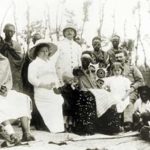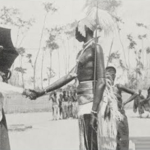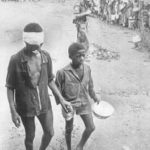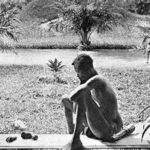European Competition Over Southwestern RWANDA
The death of Rwabugiri in 1895 plunged the kingdom into mourning for four months, and his chosen heir, Rutarindwa, assumed power. Meanwhile the royal court moved out of Kinyaga, not to return. The period of mourning was scarcely ended when the first Europeans to occupy Kinyaga arrived, an event remembered vividly by local people as the beginning of a period of anarchy and destruction. The “Abapari,” as these Europeans are called, crossed the Rusizi River in the south, and then moved north through the Bugarama Valley. They were acccunpanied by African soldiers armed with guns, dressed in black clothes with red hats and belts. The Kinyagan descriptions of the uniforms leave no doubt that these were soldiers of the Force Publique of the Congo Free State. The European officers leading them were attempting to establish Belgian claims on the area—Kinyaga’s location as undetermined territory falling between Belgian spheres of activity (in the west) and Germaninterests (in the east) attracted early European attention.
The chiefs in Kinyaga put up a brave resistance, but found their spears and bows and arrows sadly inadequate before the Abapari guns. After several unsuccessful attacks on the invading force, all the central Rwandan chiefs as well as several Kinyagan chiefs fled with their cattle. Included among the chiefs were Rwabirinda (chief of Impara Province); Rubuga (chef of Abiiru); Nyankiiko and others of the Abeerekande lineage; and Mugenzi, son of Nkombe (chief of Bugarama). The refugees reported to the royal court that it would not be easy to oust these European intruders. But military leaders at court called Rwabirinda and the Kinyagans cowards, unable to put up a decent fight. The top military units of the kingdom were then mobilized, including some ten companies with more than 8000 men.
The Rwandan forces proceeded to Nyamugari, a hill adjoining Shangi. There they waited until dawn to launch the attack. They caught the Abapari unawares, while several members of the group were away looking for food. But even with this in their favor, the Rwandans found that their weapons were no match for the Abapari rifles, and retreat soon tumed into a rout. Many Rwandans were killed in the battle. Others fled, but those who sought refuge in the direction of Nyamugari were shot down as they tried to climb the hill. Some who fled into a nearby swamp were killed by Abapari returning from the Nyamirundi peninsula. At Gafunzo hill near Lake Kivu, many Ndugan soldiers escaped in canoes, crossed the bay to Nyamasheke, and from there returned to central Rwanda. The Tuutsi chiefs of Kinyaga also fled with their cattle to Bunyambiriri and Itabire.
Not long alter this battle, the Abapari left Shangi, apparently on the intervention of German authorities in Bujumbura, and returned to Luvungi (near the Rusizi River, on the Congo Free State side). A few months later, another small group of Belgians again entered the region. These Abapari built a post at Nyamasheke, on the land where Rwabugiri’s former residence had been located. There they remained for about a year, cutting down the trees and thus desecrating this ikigabiro (royal grove).,, The Abapari occupation lasted less than two years, but during most of this time the central chiefs and the prominent Kinyagan chiefs were absent. This was to be a fact of some importance in the later shifts in power constellations which occurred in the region.
Several Kinyagans stepped in to fill the power vacuum alter the central chiefs had left. These were often Hutu from strong lineages, who had enjoyed autonomy and status in the pre-Rwabugiri period. A few were poor Tuutsi who saw in clientship to the Europeans a chance to gain status and wealth. Serving as intermediaries for the Europeans, these Kinyagans requisitioned (some say extorted) livestock and other products that the Abapari demanded for food; the Europeans rewarded these collaborators with cattle obtained in raids.
Perhaps the most infamous of the early European clients was an outsider. Seevumba, the Rundi guide of the Abapari, imposed a harsh control in the south of Kinyaga, backed by the indiscriminate use of force. Said to be the son of Rurenzwa, Seevumba was a close relative of Rwabishuugi (also a son of Rurenzwa), the chief of Bugarama during Rwabugiri’s reign. Seevumba’s interest in Kinyaga arose in part from his desire to repossess cattle that Rwabishuugi had taken when he left Burundi to become chief of Bugarama. To achieve his goal, Seevumba sought European aid.
Seevumba’s conduct was thus an early example of what later became
a common practice in Rwanda for in any colonial situation). Through cooperating with and aiding the possessors of superior force (the Europeans in this case), Seevumba was able to manipulate the situation to his personal advantage. Forwarding his own ambitions, he gained power that he then used in a way that his European patrons would have condemned, in principle at least. But the Europeans were Seevumba’s accomplices. They left him a wide degree of latitude so long as he continued to serve their goals.
Oral traditions from Kinyaga leave no doubt that Seevumba was a tyrant. Reinforced by European backing, he seized cattle and other livestock and burned huts; he also apparently appropriated women and children. Local lineage heads were coerced into cooperating with him, but often they submitted only after one of the lineage members had been killed. One man, who had been a young child during Seevumba’s occupation, conveyed some of the terror of the time:
When they killed people I witnessed that; meanwhile the rest of us were crouched down in the grass. When they came from the direction of Cyato we were lying in the high grasses where we had spent the night; they came upon us. The guide was a native of here and knew the local people—He saw my mother and her daughter-in-law and us two children. Then he said, “look out, there are some men here who’ve been dead for a long time; turn back to avoid smelling their bad odor. They climbed back up the hill and there they killed two men at Nyakanyinya. They continued past Murangi while some other ingabo went to Winteeko, where they killed three men and pillaged cattle. We were small children at the time, though capable of understanding things; but I was still young enough to cry when I was hungry. The others told me to be quiet so that the attackers wouldn’t hear. I stopped crying only when my mother gave me something to eat.
The Abapari occupation ended abruptly with the arrival in Kinyaga of a group of Africans armed with guns, coming from the north. These men, whom Kinyagans call the Abagufi, were mutineers of the Dhanis column fleeing from the Congo Independent state. They attacked the Abapari at Gataka (Nyamasheke), then pursued them along the path toward Bukunzi. During a battle in the Nyamyazi forest (Bukunzi) the Abagufi killed several Abapari. Then both groups and Seevumba, the Abapari guide, left Kinyaga in the direction of Bujumbura. Their departure was followed quickly by the retum of the chiefs from Nduga.
The next year, in 1898, German authorities established a military post at Shangi. This was, along with. Gisenyi at the northern end of Lake Kivu, the first German installation in Rwanda. The boundary dispute that drew on Kinyaga such early intense interest from Germany and Belgium continued for several years. It was only settled in 1910 when Kinyaga was declared to be German territory, as part of a larger agreement on colonial boundaries negotiated by Belgium, Germany, and Britain.
Some of Rwanda’s proudest warriors had suffered a humiliating defeat in the battle against the Abapari. Ndugan chiefs blamed Kinyagans for this catastrophe. They heaped scom and derision on local people, accusing them of having betrayed the country by cooperating with the Abapari. Muhigirwa, a prominent military leader, swore vengeance: “If I ever manage to vanquish these Shi [Abapari], I’m going to kill all of you, residents of Kinyaga. The central court withdrew its cadre from the area, leaving the local population to endure the ravages of Seevumba and others. These events demonstrated the inability of the Rwandan court to defend outlying regions of the expanding state from new types of military power. The Abapari episode also provided local people opportunities to build up clientele networks, to show the court that they were their equals. This alacrity to take up positions of command under the Abapari was important for the later imposition of European rule in Rwanda. It indicated the frailty of central authority in the frontier region and served as a warning to the royal court that it would have to come to some kind of agreement with the European intruders to preserve its power. But the court, preoccupied with its own power struggles, initially failed to develop a coordinated response.
https://uk.amateka.net/european-competition-over-southwestern-rwanda/https://uk.amateka.net/wp-content/uploads/2020/05/europe.jpghttps://uk.amateka.net/wp-content/uploads/2020/05/europe-150x150.jpgChanges and ColonialismThe death of Rwabugiri in 1895 plunged the kingdom into mourning for four months, and his chosen heir, Rutarindwa, assumed power. Meanwhile the royal court moved out of Kinyaga, not to return. The period of mourning was scarcely ended when the first Europeans to occupy Kinyaga arrived, an event...BarataBarata rpierre@ikaze.netAdministratorAMATEKA | HISTORY OF RWANDA




